Store rents had already plunged, amid a surge in vacancies. Then in the spring, the market froze; when it thawed, rents dropped to 10-year lows.
By Wolf Richter for WOLF STREET.
In the major shopping corridors in Manhattan, where sidewalks are lined by ground-floor shops, retail rents have been declining for years – and not just by a little, but by 20%, 30% or even over 40%, amid ballooning vacancies. The brick-and-mortar retail meltdown, Manhattan style. Then came the Pandemic. In the spring during the lockdown, as hospitals and morgues were overwhelmed, the market for street-level retail space froze up. Later in the year, retailers and landlords started making deals again, with “asking rents” falling by as much as 25% year-over-year, and by as much as 55% from the peak in prior years. And “taking rents” – rents actually agreed on – were reported to be even lower.
“These decreases are historic, with 8 corridors experiencing their lowest price per square foot averages in at least a decade,” the Real Estate Board of New York reported in its just released Fall 2020 Manhattan Retail Report. “While asking rents dropped significantly, taking rents are reported to be much lower, with some brokers citing average differences between asking and taking rents around 20%.”
In 11 of the corridors, available retail space further increased, with increases ranging from 6% to 67% compared to a year ago, “which reflects a substantial slowdown in Manhattan retail transaction volume and creates challenges in establishing overarching economic trends,” the REBNY said in the report.
Asking rents in two shopping corridors had bucked the declines through 2019. But in 2020, they also declined: In Downtown, on Broadway between Battery Park and Chambers Street; and in Harlem, on 125th Street, from the Harlem River to the Hudson River.
Midtown
Some of Manhattan’s most expensive shopping corridors are in Midtown. On Broadway and 7th Avenue, between 42nd Street and 47th Street, the average asking rent in the fall of 2020 dropped by 13% from a year ago to $1,653 per square foot per year, having collapsed by 55% from the peak in 2015.
But even after that rent collapse, it’s tough to imagine how a 1,000 square foot retail store, paying a mind-boggling $1.65 million in rent per year, could ever make money. And of course, some of these shops aren’t designed to make money. They’re showcases for expensive fashion brands. But if the fashion brands lose appetite for expensive showcases, what else remains?
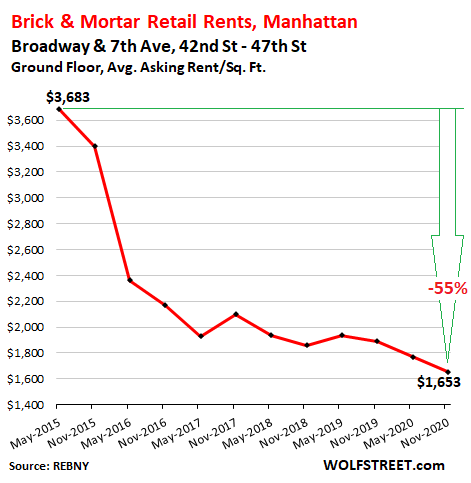
And the two stretches on Fifth Avenue: On the first, from 42nd Street to 49th Street, the average asking rent dropped by 16% year-over-year, and by 48% from the peak in 2016, to $717 per square foot per year, with 15 availabilities in the corridor:
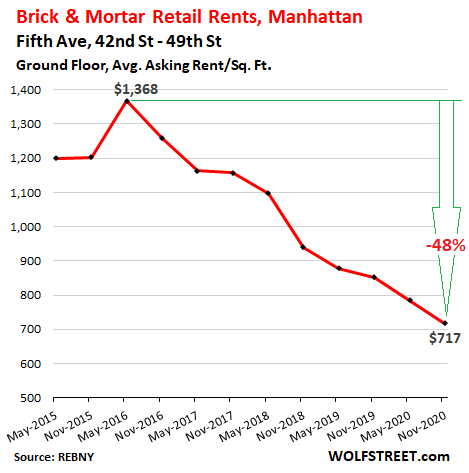
On the second stretch of Fifth Avenue, from 49th St. to 59th St., the average asking rent fell 8% year-over-year to $2,618/sf, and was down 29% from 2015. There were 17 availabilities in the fall of 2020.
But the peak in asking rents was in 2018, when landlords decided, in a what-the-heck moment, to ignore reality and ask for the sky. It didn’t work, retailers didn’t bite, and asking rents reverted to trend. In the fall of 2020, they were down 33% from the illusory peak in 2018:
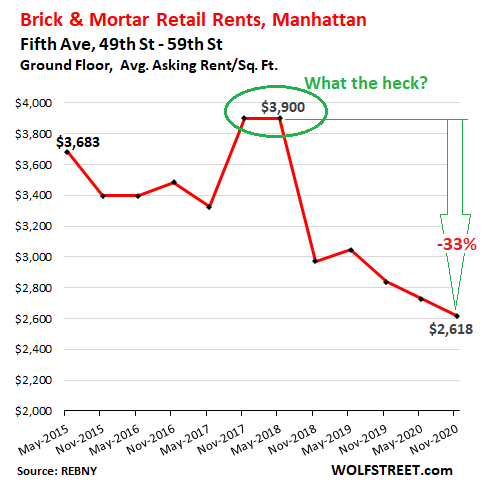
Midtown South.
The average asking rent on West 34th Street between Fifth Avenue and Seventh Avenue fell by 16% year-over-year to $441/sf, having now plunged by 56% since 2015:
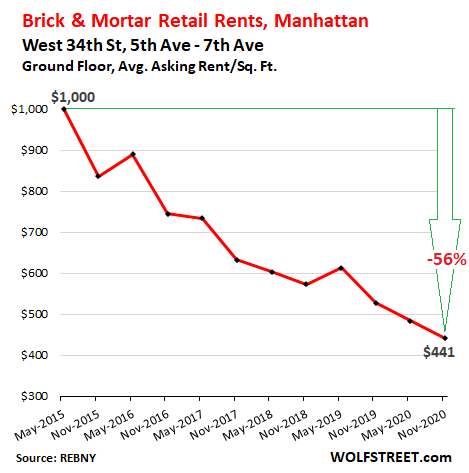
Upper East Side.
On Madison Avenue, in the shopping corridor between 57th Street and 72nd Street, the average asking rent dropped by 13% year-over-year in the fall of 2020, to $784 per square foot per year, and was down 54% from the first half in 2015, amid 55 availabilities!
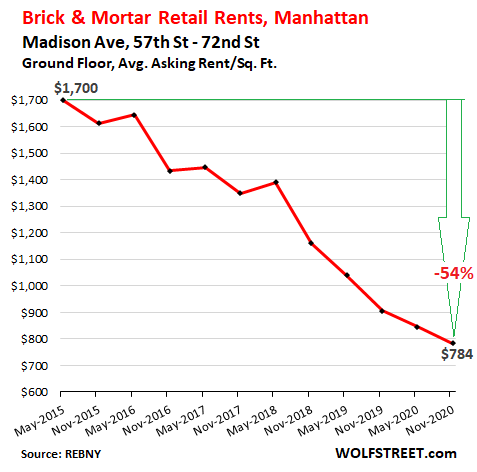
On Third Avenue, between 60th and 72nd Street, the average asking rent fell 9% year-over-year, to $211/sf, and 43% from the peak in 2016:
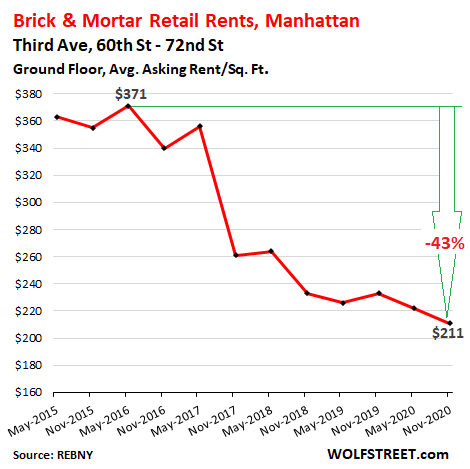
On East 86th Street, between Lexington Avenue and Second Avenue, the average asking rent fell 10% year-over-year and is down 36% since 2015, to $294/sf.
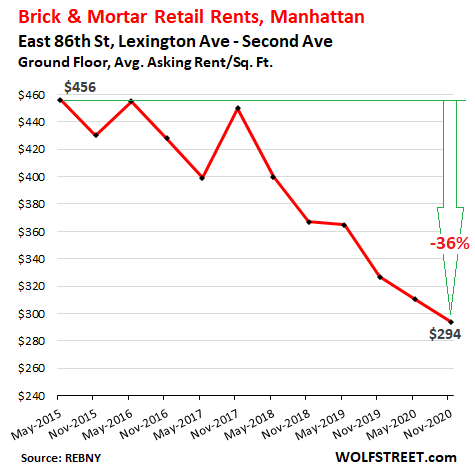
Downtown.
This is an example of just how local real estate can be, and how some spots can defy general trends, until they can’t. Two shopping corridors followed the trends as outlined in the charts above, but another did the opposite.
On Broadway, between Battery Park and Chambers, the average asking rent soared 74% since 2015, instead of plunging, to an all-time high in 2019. But in 2020, it ticked down 1.5% year-over-year:
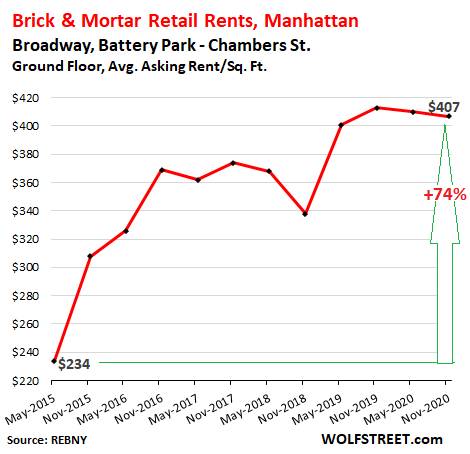
But then, you guessed it, there’s the other extreme; on Broadway between Houston and Broome, the average asking rent plunged by 25% year-over-year and by 62% from the peak in 2015, the biggest decliner in the bunch, amid 26 availabilities:
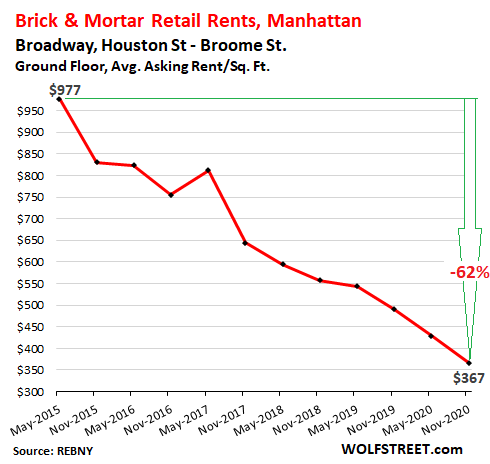
On Bleecker Street, between 7th Avenue and Hudson, the asking rent fell 9% year-over-year and 51% from the peak in 2016, amid 20 availabilities:
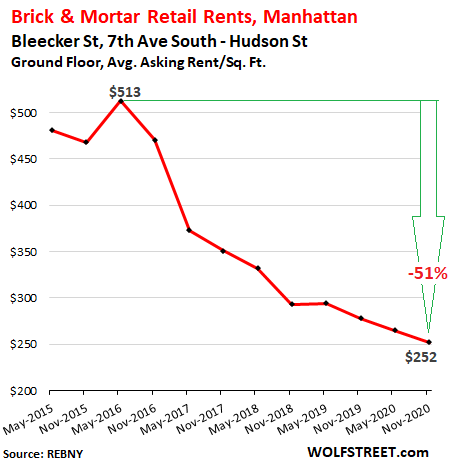
Upper West Side.
On Broadway between 72nd Street and 86th Street, the average asking rent fell 14% year-over-year and is down 42% from 2015. There were 27 availabilities:
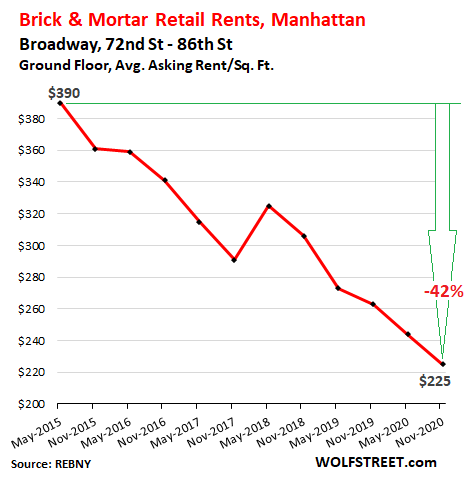
And on Columbus Ave, between 66th Street and 79th Street, the average asking rent declined 3% year-over-year and was down 35% from the peak in 2015:
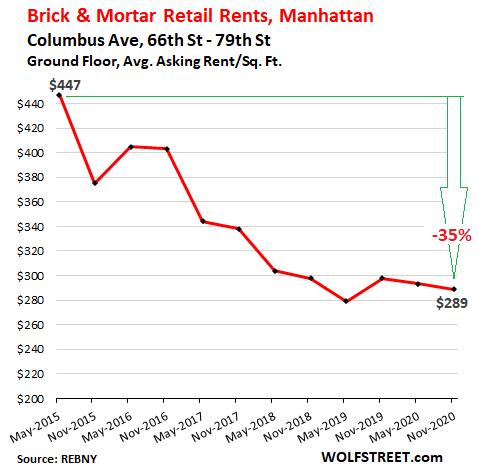
Upper Manhattan.
Another exception through 2019, the shopping corridor on 125th Street in Harlem, from 5th Ave to Morningside Ave: the average asking rent started rising in 2017 and hit a new high in 2019. But in the second half of 2020, it fell 7% year-over-year, and was right back where it had been in 2015:
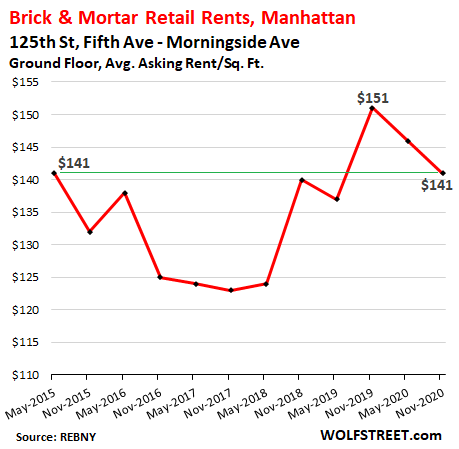
In theory, drastically lower rents would attract more interest from retailers. But the brick-and-mortar retail model is broken. Ecommerce rules. Even luxury retailers have figured out during the Pandemic how to sell their merchandise online. While grocery stores, along with bodegas in the neighborhood for last-minute purchases, and some other services-focused enterprises, such as barbershops, hair salons, and nail salons, are seen as essential by many consumers, much of the rest of retail can be and has been shifted to ecommerce. Cafes and restaurants can replace retail stores, but at some point, the street is going to be saturated with cafes and restaurants.
And when rents are too high, even though they may be a lot lower than they used to be, none of these enterprises can turn a profit. As in so many cases, the Pandemic just pushed the existing trends in Manhattan’s retail property scene to the next level.
“It was more drama than any market could withstand as Manhattan sellers started slashing prices.” Read… What an Ugly Year for Manhattan Luxury Condos & Co-ops, But the Market Came Unglued in 2016
Enjoy reading WOLF STREET and want to support it? You can donate. I appreciate it immensely. Click on the mug to find out how:
![]()


Wonderful graphs as usual. It would be interesting to gather up all the subjects you’ve covered in the last few months and highlight which parts of the economy were ruined by the lockdowns, which were boosted, and which were untouched. This segment was clearly untouched. These graphs show something unusual in 2017 but nothing at all in 2020. Upward trends continued smoothly, downward trends continued smoothly.
The sooner New York dies, the better. It has been on graft-fueled life support for 40 years. Give it back to the Indians.
Excellent example of purposefully selecting charts with two different start-end X axis years to make two different points. See lots of “why did you?” here about that.
Also learned new word “bodega”, and it’s two other related shop types and their Latin roots.
Bodega Bay no now has me wondering.
I walked around many named “landings” (points or headlands was another term for them) with old structures for running cargo to/from ships on ropes/cables all up and own the Sonoma/Mendo coast and how a lot of people I know up there and here got rich during prohibition, since I was raised there.
Wish I knew NYC better, but it isn’t hard to see commercial real estate is hurting badly.
An economy based on 70% services is one of the reasons the dollar is dropping against the yen and euro, IMHO.
Green New Industry!
NY governor and NYC mayor talking about opening up soon! Hoocoodanode?
Wolf posts.
Cuomo pivots!!!
(“we will have nothing left to open”…”must reopen”).
Hmmm…wondering if once the NYC landlord class really starts taking it in the neck on valuations (as rents collapse), the political class leaps to attention.
No industry is more geographically locked in than landlords and being so vulnerable, I wouldn’t be surprised if they are the most politically plugged in of all businesses, period.
They and the cities/states are welded at the hip.
If only Wolf has such power over Gavin.
LOL.
New York is the epitome of government idiocy and corruption. Because of businesses and people fleeing NY, Cuomo threatens higher taxes. My god, these people are stupid.
The silver lining is NYC is getting cheaper; now when NYC goes bankrupt (again) and US taxpayers have to bail it out (again), it’ll be less expensive.
“politically plugged in”
Much like the big landowners Steinbeck writes about in his books and SF newspaper articles. Local authorities and law enforcement did their bidding against the poor immigrants; vagrancy laws, protests, strike breaking, even beating, shooting, and such.
A lot of similarities to the way those shoved to the bottom of our society through no fault of their own are treated today, no?
And speaking of “plugged in”, how in hell can anyone justify Citizens United?
As on of my Canadian friends said, “When Corporations can suffer capital punishment, then they can be treated as “people”.
Lobbying as it is, is bad enough. I’ve seen it at length and first hand and close up on the powerful Senator level.
Sadly rents are still too high. They need to fall much more.
Where is The Rent Is Too Damn High Party when you need it? Yes, that was an actual thing…
Wes,
Given all that’s happened with the Pandemic, the most feasible outcome is that the whole concept of New York City has become redundant.
People have said this about NYC time and time again as the city has gone through its standard cycle: cheap concentration and opportunity becomes available, people resettle amongst the bombed out slums and high crime, things pick up, gentrification, over-exuberance, and finally collapse. Then repeat. I do accept that maybe “this time is different” but in the long term, even despite of the incredibly strong decentralization power of things like the internet, there is still tremendous value in dense Urban centers for many (but not all) people, cultures, and businesses — it just needs to be repriced correctly which is much much much lower than where it is right now. In terms of the absolute theoretical bottom line, typically high density and volume create a savings on cost so it is theoretically possible after a very long and extremely painful repricing of things, dense urban living could become cheaper than rural living at which point it starts to look pretty good again despite the internet and such making massive decentralization both possible and inexpensive.
So while I admit that “this time could be different,” based on the history of NYC I would say what I expect to happen is that it will need a couple of decades to finish collapsing, and then a couple decades after that the first wave of brave new “settlers” will start repopulating the bombed out crime and rat ridden ruins and the slow climb upwards to glory (and then a subsequent new collapse) will begin yet again. Everything you are saying now, sans details like the internet, people were saying about NYC in the 70s.
The key element that’s different is the death of commuting. Once that has gone, there is no need for any head office to be based in any of the traditional major conurbations, nor consequently for all the businesses that service the commuters and the city residents that work in them. Add the flight of rich residents looking to avoid restrictions and the major drivers of city growth collapse. Given the further subsequent loss of low wage jobs to support all that and the inability of said workers to move, NYC could be a wasteland within a few years.
They’re going to need a “woke” Rudi Guiliani to clean up the rising crime rate with love and kindness.
No one goes to NYC anymore, its too crowded.
Yeah, and if people don’t come to NYC, how you gonna stop them?
That’s a good one, Dan, Yogi would be proud of you.
NBay:
That is a Yogiism. I keep a list of nineteen of them taped to my fridge.
One that may apply to comment board responses: “Never answer an anonymous letter.”
That spun my brain around a bit.
My son just moved out of Manhattan, back to stay with me for a year or so and work on-line. It was such an obvious thing to do and probably allow him to save about $3000 per month. The high rents mean nearly everything is more expensive there including groceries and anything bought at a store front.
The thing I am not sure of is on-line really going to be a good business for investors after the reset in stock prices. At least where I am it seems inefficient for someone to be driving a 2 ton vehicle around and walking up and putting a small package on your door step. Doesn’t seem to pencil out unless it’s a relatively expensive item say $100 or so.
Transportation rarely gets much scrutiny. Uber is pushing down on labor costs, while energy costs are high relative to volume, as you say. Any glitch in corporate credit will put even more pressure on energy. Low cost food delivery costs were the trial period, now they can ratchet up. Yet most retailers still ship free for $35. Bound to hit the corporate bottom line, let’s see if there are some warnings this earnings season.
The package drop-offs are so common now, I bet the driver only needs to adjust his/her route by a quarter mile to deliver any particular package. This assumes they have some logistical software that minimizes delivery distance.
I do have my doubts about this, though, in these early innings of package delivery. Every day I see about 10 trucks deliver on my street, and they are all different trucks delivering at different times.
Eventually, it should be efficient overall, but I doubt same day delivery will ever be economical. That’s just stupid, except in case of emergency goods. If people don’t have enough patience to wait two days for a nonessential product purchase, the human race has much bigger problems than package delivery.
What keeps delivery personel honest (e.g. the mail) is a good wage and a safe career. Shifting delivery to itinerant pieceworkers kills that, nevermind the complete ineffectiveness of the police in stopping porch pirating.
You are completely and totally wrong about the US Mail, Sailor. “The Sanctity Of The Mail” is strictly enforced by the Postal Inspection Service.
Swipe a piece and take something on the floor that spilled out of of letter or package at peril of Leavenworth. Period.
Everyone is being watched constantly, or at least have no way of knowing they are or not.
I was an Electronic Tech there for 18 years, and have seen two busts, and heard of others. The Inspectors play for keeps, even management is afraid of them.
Sailor
“What keeps delivery personel honest (e.g. the mail) is a good wage and a safe career. Shifting delivery to itinerant pieceworkers kills that, nevermind the complete ineffectiveness of the police in stopping porch pirating.”
That’s beginning to happen. Some entity with a contract with Newegg, which doesn’t seem to have the best logistics anyway, sent some poor soul in his own car to deliver something to me from a depot 70 miles away. The guy didn’t seem very happy, probably lost money on it with gas and car mileage/upkeep even taking into account a few other deliveries in the area.
Other than that, Uber/Lyft just spent millions to keep their workers “independent contractors” as do a lot of Corporations. Then they can push them all they want with no responsibility for anything they do at all. All they have to do is fire them, let the police have them, let them go bankrupt, whatever, and then turn it over to their PR department for a few well chose public statements. It’s actually better than real slaves were, much much better.
Very interesting article. Of course, the only experience I have had with NYC retail is watching Kramer squeezing fruit in Seinfeld, or the cast in the cafe, but I get the point. The bodegas and cafes will stay, along with bakeries, liquor stores, butchers, and maybe small drug stores; souvenir shops for touri. The remainder goes online. Seems to me a natural progression; something full of common sense.
The article did not answer one question I have. Despite the store owners and the minimum wage employees, does anyone really care if these places go under?
Then again, I hate shopping so never will ‘get it’.
Maybe some of these places could morph into small cafe/bar entertainment places like the coffee house scene of the 60s that gave so many artists their start? Why not? Nobody is working anymore. (I’m only half serious). They would also make nice apartments since they already have the roll up steel mesh for nighttime security. Hit the switch, hunker down, and wait until it’s light enough to venture out.
“The remainder goes online. Seems to me a natural progression; something full of common sense.”
But then ultra high cost NYC becomes Sheboygan with a rodent problem.
Paulo,
“…does anyone really care if these places go under?”
People live there. And I see this in San Francisco too. Boarded-up shops are everywhere, and they’re a blight. So as long as some business is in it and takes care of that place, fine, whether it’s a cafe or a barber or JPMorgan Chase branch. But boarded-up shops are terrible.
Trickle up: Insurance premium spike(s) will dwarf diminished rent costs. Multiplicity effect will playout in all cities/locales.
“Portland Businesses Face Rising Insurance Costs, Decreased Coverage After Riots.” (source: KGW)
Yep, talked to a business owner here in a riot area who didn’t care that his pharmacy was looted. Neither did the police who stood down. “Call your ins company” was their response. Now their insurance is going up. OOOps.
Swamp Creature,
Did you “talk” to anyone at that more recent DC “riot area business” that was “looted”?
It’s “insurance cost” is going up also….I’d wager it’s thousands if not millions of times more than the pharmacy’s.
If you’ve lived in SF for awhile you’d know that that used to be pretty common in the 2000s and then again after ’08.
” Of course, the only experience I have had with NYC retail is watching Kramer squeezing fruit in Seinfeld, or the cast in the cafe, but I get the point.”
Seinfeld was mostly filmed in Los Angeles. Too bad there’s been nothing as funny since then. But I guess lightning does not strike twice.
I thought rules of engagement was up there with seinfeld.
These situation comedies set in NY make me laugh. Nobody ever talks about cockroaches. People wearing designer clothes living in large, well maintained apartments in trendy areas while working part-time minimum-wage jobs—many driving expensive cars with no dirt, door dings or rust.
Yep, that Friends apartment would be the easy equivalent of *6 to 8* real life Manhattan apts.
And you are right…it has been a *long* time since the intractable NYC cockroach problem was even raised for comedy.
(Per Friends, I don’t remember any “The One with the Roaches”)
The city is portrayed in media as glamourville…but for 85%+ of the population…it is a long, slow, cold, miserable slog barely offset by the job opportunities/pay.
Really depends on your sense of humor. I always thought that show was a bit over rated and there are a number of shows since that I have thought were far funnier but you very well might despise outright. Its all subjective.
Wolf, Is there any way to get some rough rent data points in NYC from 1979? That was the first time I visited NYC as a college student and it seems like the situation we have now is taking us back to there in a hurry. We might find it very relevant to where rents could be heading in the near future.
I can’t even find my college grade reports from that time LOL
In ’78-’79 I was a freshman at Montana State University in Bozeman MT. Years ago I found all the canceled checks I wrote that year, stashed away in a box. The total for 3 quarters of school, with a full load of 18 credits was ~$1862. That was staying on campus and eating in the residence hall cafeterias. (Had the full ride 20 meal plan.)
At the start of the quarter you’d line up outside the field house. Go in, get your schedule and write one check for the quarter. One or two trips to the student union bookstore for text books and supplies and that was it.
To pay for school I worked in the woods and ran a chainsaw during summer vacation. Net would be about $2400 for the summer. My brother and I were cutting Lodgepole pine for fence posts. I’d pay him about $800 to help get the stuff out of the woods and to the yard.
Good luck with that for kids today. Mega ::sad face::
That was back when the legislature paid 90% of the tuition for in state students.
Don’t forget at that time university staffs were paid upper-middle class salaries. Also the administration bureaucracy was minimal. Recently looking at colleges and I was shocked to see more administrative staff than teaching staff. On the other hand, in the 1970s, Montana State was really just a glorified high school.
Nice slam at Montana State!
You must be a grizzlie from Univ of Montana.
I found your college grade reports in the same box with mine……smelled like 30 year old beer.
In 1979 you could rent a studio in Gramercy Park, with a view of the park and a key, for $250 a month. A one bedroom was $350 but harder to find.
A backdoor way of determining rent is to look at the tax data for the period, or look at rent stabilization rents for the period, which are govt numbers.
https://en.wikipedia.org/wiki/Crime_in_New_York_City#/media/File:NYC_murders2.png
This graph of the NYC murder rate whispers to me that the rates probably stayed reasonably low until the mid-1990’s.
That is total murders, you want to try to find a murder per capita graph somewhere. Most people who lived in NYC from like sixties through post 2000 will tell you the mid-nineties is when the murder problem started turning around in a big way. People were starting to come back to the city en-mass by the mid nineties so the murder per capita was actually going down. Its the 80s that were the darkest of times RE: murder as well as other violent or serious crime, the population of the inner city burrows was down over 10% relative to the 70s but the total murders per decade was slightly up!
It’s not the murder rate you need to look at, but the number of shootings. Many people shot recover due to improving medical advances, or in the case of ghetto trauma centers, surgeons with a lot of experience patching people up. Now the average victim survives, but has still been shot.
Wow $250 that’s beyond compression today. But thank the lord’s in high heaven – and the Federal Reserve of course – because today’s rent would not be due to inflation. Because there is none. In fact nothing is inflation. Because inflation doesn’t exist. This time is different.
Didn’t you hear? Inflation is good.
Millie,
Yep, since at least the internet bust, DC/MSM has been treating increased inflation like some sort of affirmative good/goal…and that even a specter of deflation (lower consumer prices) the Dawning of the Apocalypse.
Of course, if the G is to bail itself out using its Master Forger powers, it has to first condition its cattle, er…voters.
In 1981 I rented a studio in the East 20s for $300/month! Rent controlled, of course. NYC was actually cheap if you had even a basic decent job.
Back then, and into the 90s, the city was far more accommodating to all people. It appears it is going to be that way again.
East 20s?! In 1981!!!
What did you do for a living?
Hired killer or heroin dealer?
In fairness, the 20’s might have been a few blocks short of this…so you might have only been Death Wish adjacent.
E-commerce rules because the rats haven’t figured out that the maze ends in their eventual destruction!
May they get what they receive – and good and hard!
Polecat:
I have heard that for the real rats of NYC, the pandemic has meant starvation as many restaurants closed cutting off their local food supply.
I wonder if the rats have moved, or adapted, or learned to code?
They’re still in the henHouse, feeding on our dime, with some redRhinos guarding the exits.
They’re coding
Never lived in NYC, but for what it’s worth they DO come out of the toilet and often. Made it very difficult to enjoy one of our bodily functions.
That Gold Lady you like (former housing…) – (don’t mean to be rude just tired of bs and drinking) had a great post somewhere the other day and this seems to fit in: “is it a meltdown or a land grab -?”
Yeah, both. Brick-and-mortar retail meltdown and single-family house land-grab.
Yes, it’s Shimmered!! .. a deserted toppingoff, AND a Floored, waxed!
The only thing that will revitalize those areas is for asset prices to come down, new owners will be able to justify much lower rents based on a smaller purchase price and we can finally start to have some economic growth. But Powell has decided otherwise for now. Let’s see how this plays out.
And what will happen to the property taxes? If they are high, the new owners will not be able to discount as greatly. This will affect tax revenues and so on. That is one of the great things about California and Prop 13. This, the taxpayers, got right.
My understanding is, the low tax doesn’t get passed on to a new buyer.
No need for US in-house tech development….just outsource already.
re Seattle Times – business/boeing-aerospace/boeing-to-close-its-storied-seattle-manufacturing-rd-center/
Reminiscent of Motown’s transition from technology leader [in its day] to an assembly point (from global components) of product.
Happy motoring…..
@Wolf As you point out, in spite of the rent collapse too many stores are still boarded up. Is it all e-commerce or are rents still too high?
Olivier,
Possibly a trifecta of consumers fearing to shop at physical locales (excluding Costco, HD/Lows, ect.), employees making more not working (ymmv), and insurance spikes (see reply to Senor Wolf comment above).
Btw WA state governor has deemed ‘strip clubs’ good to go w/reopening. Essential services!
Olivier,
When rents are too high, it will kill a business or drive it away. What happens a lot is this: a retailer/restaurant signed a 10-year lease in 2008, and in 2018, when the lease comes up for renewal, the landlords says, OK another 10 years, at twice the monthly rent. So now the business owner has to do some hard math. If the owner cannot work it out, they’ll just shut the place down. Why work so hard to hand all your profits plus some to the landlord? This happened all the time in San Francisco (pre-Covid). A lot of times, the landlord cannot find anyone to move into the space, and the space sits empty. But the landlord might not be able to cut the rent enough either because of their own obligations. So pre-Covid, we started getting all these empty stores.
This was made worse by ecommerce, which made life much more difficult for retailers. So those two – high rents and ecommerce – come together and form one nasty headwind for these small retailers.
Service shops, such as barbers, are not impacted by ecommerce, but they’re impacted by high rents. The shop will lose customers if it raises prices too much. They’ll go to the next barber. Then there is substitution: I got pretty good cutting my own hair, and it’s faster because I don’t have to go anywhere, and I won’t go back to the barber.
Wife and I have been taking turns cutting each others hair, accompanied by Bugs Bunny blasting “The Rabbit of Seville”. Makes for an awesome date night!
OK but at what point will rents have fallen enough to make small stores (not obsoleted by e-commerce) viable again?
“I got pretty good cutting my own hair,”
Wealth effect, substitution effect,…Flowbee effect.
I always suspected you were secretly George Clooney, Wolf.
Willem Dafoe, not so secretly :-]
As a property owner building s cost money upkeep nonstop tax increases and insurance go up every year my real estate insurance broker told me insurance company knew more about me than govt of course govt will have to adjust property values less tax revenue bye bye pensions and services read Buffett book snowball it’s now reversing
I know inflation has been pretty tough this year, but surely you can afford to buy a keyboard with punctuation keys.
As a former HS English teacher, I agree.
It’s excruciating trying to read free flow thought.
Even James Joyce used some punctuation.
See also: Victor Borge and punctuation.
Rents for both commercial and residential properties have escalated a huge amount in the 30 years prior to 2015. Is it really surprising that rents for both are coming down.
If work from home becomes permanent, that means that demand for commercial properties will also decline a great deal. That in turn means that demand for apartments – both to own and to rent will also decline a large amount .
If the trend of online shopping continues , that means that demand for retail stores will decline and many stores will be forced to close.
If the call for reduction in police forces becomes a policy , that means that those cities will become more dangerous and less attractive.
As people and businesses leave the city, there will be less money and basic services will be cut.
As the FED losses control and interest rates rise to realistic levels , it will be both harder and more expensive to get a loan and prices will decline.
We are entering a perfect storm for many cities . I believe that all of the above conditions are realistic and probable and will lead to a crash in real estate prices
Ah! … those beautiful highrise RUINS! ….
the Nth Wonders of the World
Seed them with mountain goats and Kudzu, and wait-n-see what evolves.
If they sit there long enough without attention, the earth will consume them.
There used to be some TV show about after man is gone. Showed the different critter ecologies at different building levels.
Not to worry. Sam will bail them out.
Spoken like someone who has never lived in either of those regions. In fact money works differently in these areas. Wages are much higher and property taxes are much higher (in dollar terms) than in other places. Therefore, a fixed amount dollar deduction is equivalent in these regions to that of podunk, USA.
It’s silly to say that a fixed deduction is the same for someone in CA who makes 3x what someone in KS makes, but whose property taxes are 3x as much as well.
The change you describe would not be a “giveaway to the rich”, it would be “a giveaway to the CA/NY middle class”. And I guess we can never have tax giveaways to the middle class can we? No, they must always be screwed the hardest possible of anyone on any end of the financial scale.
Reverse Donald Trump’s tax changes, all of them – except maybe the state tax deduction, because I do believe that that disproportionately ‘rewards’ high-tax states.
Meant to say “a fixed amount dollar deduction is NOT equivalent in these regions to that of podunk, USA”.
“except maybe the state tax deduction, because I do believe that that disproportionately ‘rewards’ high-tax states.”
Absolutely NOT, that has to be reversed too. Those were ridiculously bad choices aimed directly at the hard working in CA. Unless we can convince Gavin to drop the ridiculous sate income tax, something we can learn from our friends up North. Talking about Washington state. Just go ahead and raise the gas tax, then blame it on the oil companies, it works well anyways, and also need to play up the green angle by upping the credits for EV, and renewable energy.
The Middle class need to thrive… especially in CA, so bring back all of SALT deductions.
FDRs first act after inauguration was to close the banks(hint, hint). I’m not expecting anything better than a collapse, considering all the deliberate distractions.
One of the NY CRE success stories might be in Brooklyn where neighborhood shops seem to be proliferating. There are also upscale outlets there in a section called Industry City.
There was heavy Russian influence on ’07. (Bed-Sty?) Ate at one fast food place with a Russian play on words…. yes/no looked sorta like “dinette”. Good stroganoff, but not much of it. Brother’s girlfriend lived there.
The one next to Coney Island…..I can’t keep my sub-boroughs straight.
BTW, bro’s GF was Ukrainian immigrant….spoke Russky…..her looks proved those Vikings went a LOT of places. Me and my brother got our Dupryten’s from both sides of the family.
Benson Hurst! Finally!
Getting old in the brain sucks.
What we are witnessing is another example of an inflationary bubble deflating. There are numerous examples and spread throughout the economy. One next likely to manifest is higher education. Signs were developing that things might go downhill for many colleges/universities; especially the boutique ones. Of course, if Biden moves to forgive some student debt, then that bubble will likely reflate. (BTW, George W. Bush was responsible for making student loans not dischargeable through bankruptcy. Their (magical) thinking at the time was that this would force more accountability for costs (by the students) to the colleges. Of course it didn’t work and things got even more bubbly.) And finally, residential real estate bubbles have come and deflated in various areas; and will continue to do so over time.
Making these loans dischargeable again would be inherently fairer (to all and sundry, but especially those fools who worked and sacrified to pay off their loans) than forgiving say $50k.
That would also have the benefit of fulfilling the first part of the WEF’s 2030 prediction for us all “YOU WILL HAVE NOTHING” … they just have to work on the “YOU WILL BE HAPPY” part …. or maybe they’ve got soma lined up for the masses ….
Yes, the magical thinking that people going to college would be smart enough to figure out a simple cost versus benefit analysis. The news regularly reports stories highlighting people borrowing over one-hundred-thousand dollars to get worthless degrees, then finding out they’re job opportunities are limited to minimum wage jobs.
17 year olds are notorious for making bad decisions.
Not sure why you would think someone about to graduate from high school would be able to do a cost benefit analysis.
If a 17 year old can’t perform simple math, then he should not go to college. And most likely shouldn’t vote.
M Friedman,
With talk like that you picked a perfect screen name.
Pass the homeless 17 year olds some of that trickle down, please.
M Friedman,
17-year olds can’t vote anyway. You’re a real rocket scientist yourself
The major inflection point in student debt load appeared to be in 2005– at that time it took off and never looked back. Total such debt in 2005 was ‘only’ about 1/4 Trillion dollars.
In 15 years since then you might think word would get around and high school graduates would get an inkling that racking up big debt for a dodgy liberal arts degree might not be a stellar idea.
But no, they have flocked en masse to universities and colleges ever since, like a teeming crowd of cliff-bound lemmings. Devil take the hindmost.
Now, those who could not or would not pay their debts are expecting a bailout from El Presidente Biden.
You can’t make this stuff up.
They are all scared shitless of raising tax revenues using IKE or at least JFK level schedules. Bush 1 probably got voted out for it.
A lot of these problems, MMT, etc, lies at the “Reagan-Puppet” handlers feet.
“Speak a little faster Mr President” -CEO of Merrill Lynch at one of Reagan’s speeches.
Maybe they could turn all that street level retail into a giant red light district, with gambling halls, speak easies, bare fist boxing, and smoking lounges too. If we are going to imitate the 1930’s economy, might as well do it right.
Bingo!
Wolf – FYI, an inconsistency:
The first graph is labeled “Broadway & 7th Ave, 42nd St – 49th St” but the accompanying text says “On Broadway and 7th Avenue, between 42nd Street and 47th Street”.
Thanks. 47th.
Petunia..it’s simple to be an entrepreneur in Brooklyn even if there wasn’t pandemic because alot of apt/loftr dwellers do NOT pay any rent ZERO &
some I know haven’t paid anything for 7 years! Not so tough to have a retail space.In 1989, I remember being in the SF Bay Area & paying for an apt for myself, a studio/1 bedroom rent for my college son AND renting my retail location. Rent X3. Ouch….when I realized I could go “on line” & sell without paying rent, my life changed for the better!
There is another significant, high-end shopping corridor in Lower Manhattan: Prince Street. Prince Street was devastated during the riots late May – early June. Windows smashed, store interiors vandalized, contents looted. Police did nothing. Never did I think to see Prince Street boarded up. No idea if those stores re-opened. I ended up fleeing NYC to escape the lawlessness. Never did I think I’d see Macy’s on 34th destroyed, Saks Fifth Venue boarded up and patrolled by private security with dogs, Fifth Avenue shops boarded up. I suppose DeBlasio is blaming Covid for stores closing and residents fleeing, and not the lawlessness. Somebody needs to film “Escape From New York 2020.”
Maggie,
LOOK AT THE CHARTS!! They don’t start in May. They start in 2015.
Maggie has a point, the lawlessness policy in NY started under de Blasio in 2013. It’s only gotten worse.
The number of murders in New York City has been falling since the 1990s and dropped to a 70-year low in 2017 (as far as the chart goes back to).
https://en.wikipedia.org/wiki/Crime_in_New_York_City#/media/File:NYC_murders2.png
Maggie
You’re stealing my idea.
Thought you were a DC expert?
The real crime wave in NYC was in the 1990’s in the David Dinkins administration. The shootings were in the thousands.
What was the underlying cause of all the murders? Drug related? Just all crimes in general? I’m just curious….
When I lived and worked near downtown Detroit in the mid 70’s, the murder rate was high due to a lot of drug gangs fighting over territory. There were lots of outright executions and bodies floating up out of the Detroit River. Was NYC any different?
I think it was considered to be caused by the crack drug epidemic, which was exacerbated by the city being broke and cutting back on social services. But it was the culmination of the city following the liberal policy of benign neglect on many fronts.
Thanks. Detroit city management was no better back then and their problems were following a big mess of riots.
I was in Detroit in ’71 to visit wife’s (since HS) pen pal. Saw bumper stickers everywhere that said, “Hungry? Eat your Toyota”.
Unfortunately they were better cars…with less marketing….people do learn some things fast.
Sat on porch with the man of the house and he was bragging to me about how the cops could get anywhere in 3 min….except the inner city, said they just stayed out of it completely.
Some years back I knew an EVP for Nordstrom’s. Asked him how all those little shops stayed in business. He shrugged his shoulders and said damned if he knew.
Spoke with a guy renting a small storefront in Bellevue Square (Bellevue, WA) a few years back. He and his partner were replacing phone batteries snd selling misc paraphernalia for phones like cases and chargers. His monthly nut was…$5k/mo rent alone. He bluntly told me they were barely making that.
Where I live now there are plenty of B/C mall spaces available. You know some of those are being offered cheaply when you find a small hair and nail salon a few doors down from a Big Lots and Harbor Freight. And there is still empty space available.
I wonder how much money pension funds and insurance companies are losing on these deals.
Another 5 trillion or so of new fiat should replace lost taxes and pensions. This is the next big printing job for the Fed. It will happen. Extend and pretend is fixing to explode. MMT has been enabled by C19 and govt. will not and can not stop. The party has just started. The new Congress is drooling from the anticipation. Buckel up , seats and trays in the up-right position for take-off.
Well, I for one, would hope that those hanging masks .. suddenly dangled above one’s head neck-deep in arrears caused by those in the No! .. are able to suck up some needed high-octane quatloo$ asap! All one has to do is look out that coach window seat, to see the choppy waters below.
Also spotted – the U.$.$. JOE BIDDIN, about to be capsized by some rather large rogue waves.
Wow. My first apartment was on the UES in 1991. The rent was $615/mo.. Next was a rent controlled place in Soho – $497/mo.
Monetary inflation seems to hit NYC first, as the effects went straight to the banks and money runners. I doubt it this time, so many wealthy people are just gone, with no plans to come back.
Mean reversion sucks. We could see condos selling for a buck, the common charges and taxes are enormous.
One of the good consequences of covid is the acceleration of WFH. Unfortunately, no industry is better equipped to do this than financial services, which is highly automated. This has allowed those high paid workers to move anywhere, while low income workers have been totally displaced.
Petunia
Good???? No this is great!!!! Businesses using this pandemic to offload all their overhead to the employee and their family without one dime of compensation. Someone is drinking too much of that Corporate cool-aid. And what about the low paid service workers busting their a$s just to put food on the table for their families and losing their jobs. Oh, just collateral damage. Corporate bottom line is what counts
Petunia
NOT WFH = Work From Home
SOON WFI = Work From India
Sadly, I am right about this….
Stealing my thunder again. WFH -> WFI was posted by the Swamp Creature about a month ago.
I think I made my point badly because SC and OTB didn’t get that I was referring to the worst possible people, financial services workers, benefiting the most from WFH. For them, WFH is easy, cheap, and global. Not much outsourcing to be done because many are already offshore, in the Caribbean.
As far as India is concerned, they can take low level jobs, like call centers, information processing, etc. But they don’t have the credibility yet to attract private wealth management accounts.
Prescient comment.
WFA (Work from Anywhere in world) does indeed imply you can more easily ditch expensive home-grown employees and reach across the seas for cheaper replacement foreign workers.
A segue to that outcome is companies cutting employee base salaries if they move to lower cost of living areas.
I suspect corporate heads will deduce there is less employee skin in game if they work 2000 miles away from company– thus easier to cut the cord.
I would like to get rid of my US dollars before they devalue 30%. I’d like to exchange them for Swiss Francs and just put them in a safe deposit box. Wells Fargo has a display of the exchange rates in every branch. The only problem is the buy sell spread is about 8%. Wells Fargo is based in SF. Anyone have any good ideas?
I think you can buy SF from UBS delivered to you and you can order by phone.
Maybe a currency ETF?
Lou Mannheim
I want the actual currency. Not some piece of paper or phony certificate from some crooked broker firm. A friend of mine did that with a gold ETF and the firm went bankrupt.
Some ETFs do provide for delivery of the underlying assets, you just need to do the research (and ensure your broker will also take delivery).
About every 30 years, older Swiss currency is given a grace period of 5-10 years before it becomes devalued from a spending standpoint.. For instance 1970’s era Swiss banknotes are worth nothing.
A government is a strange entity, they can take a useful piece of paper and render it useless by printing all over it.
Swamp Creature
Gold and Gold/Siver mining ETFs are NOT a buy&hold but for trading vehicles(both directions) subjected volatility, strength of the US $ and geopolitical events.
I have small amount of gold ETFs as part of diversified and uncollateral assets. Rest for trading only especially with options.
Sunny, you once said you were a Medical Doctor. It’s on record here at WS.
Did you quit your clinical work to become a trader? Why? Are you a Ben Carson type “Medical Doctor”?
He was worth $11M when he ran for Prez…..that’s a lot of surgery, eh?
Just curious.
Retired medical doctor who’s doing some trading to have some fun and add to the kitty?
Fair enough. But any still working doc who isn’t in clinical practice at LEAST every other week should drop that MD suffix, i.e., Rand Paul, Ben Carson, et al, in gov’t and elsewhere. Or at LEAST not be listened to publicly and officially as an authority on medicine.
Like in that sham GOP hearing on C-Span (no Dems) on best Covid medications with only two GOP Congressmen, the chair and “Dr” Paul, with the CEO of a drug company along with three other similar witnesses. I looked up all the stuff they were pushing with actual “data” charts” as therapeutics for Covid and was bombarded with pet worm pill ads.
Worst Congressional circus I ever saw, and there have been a lot of them.
Docs disagree a LOT, that’s why they call it the PRACTICE of Medicine.
But just like cops, they don’t like contradicting or bad mouthing each other around laymen as it puts doubts into people’s minds about whether any of them can be trusted or not.
With big Pharma and device manufacturers and HMO, hospital managers pushing them so hard
to sell “product” and make “profit” (TV ads…WTF?) it makes them all suspect, unfortunately, IMHO.
There was a company in the Swamp a long while back that was a gold trading company, called the Henry Company. I met the son at a wedding. He talked me into buying gold. They mailed it to my office and it almost got lost. So the next time I went in and paid cash for the gold and got immediate possession. My apt was burglarized 2 weeks later and I almost lost it all. They took TVs and jewelry but left the gold on the floor in plastic cylinders.
My friend who recommended the company invested in the same company but sent them money in the mail. The company went bankrupt before they got delivery of the gold. They lost everything. They hired a lawyer and sued, but got nothing because everything was legal. The court ruled that the Henry Company just got over their heads. Nothing illegal.
I can see these type of firms popping up all over the country as people look for safe havens for their money when it starts to devalue 30% or more.
Swamp Creature,
The Swiss National Bank (SNB) is trying very hard to reduce the value (exchange rate) of the Swiss franc against the dollar and the euro by printing unlimited amounts of Swiss francs and buying dollar-denominated and euro-denominated assets (bonds, stocks). Proportionately speaking, the SNB is the biggest money printer in the world.
By number of cash in circulation, that’s actually the USA. By virtual cash? Still the USA. By debt? The USA.
Yeah, it’s also the largest economy in the world. The Swiss economy by comparison is a flyspeck.
What happened to the good old days when if you wanted to buy (Gold, Silver, Currency etc) you could go into a dealer, plunk down the cash and get the item, right then and there. I’m not interested in intermediaries or dudes out of state, talking gibberish on the phone, sending stuff through the Postal System, or UPS. I can’t even get my important mail sent or delivered properly here in the Swamp.
By the way, I just got an e-mail from BOA stating that the mail system in the Swamp is not functioning. Like I didn’t know. The Post Office system is non-functional and has been that way since this summer when the BLM/Anitfa riots started. Mail not going out, mail not coming in, mail delayed for 1 month. mail stolen and checks forged and cashed. I’m still getting Christmas cards 1 month late. Yesterday, the dude showed up at 9PM to deliver the mail. I asked him why it was so late and he said the other carriers called in sick. We’re already into 3rd world country status here. The only mail coming in reliably is junk mail that I don;t want and throw into the recycled bin without opening it.
“The Post Office system is non-functional and has been that way since this summer when the BLM/Anitfa riots started.”
Trump administration tried to GUT the Postal Service last year so it would not be able to deliver mail-in ballots in time. That’s when the problems with slow mail delivery started. Same here in San Francisco. Now it takes forever to get something that has been mailed.
There have been big money types trying to cherry pick the best parts of the PO’s services for 40 years. They don’t see same price letter delivery to anywhere as a “good business model”, among other things.
They do usually utilize the GOP for all their dirty work though, I have to say that for the Dems.
RE: Postal Inspectors
Another Federal crime is “Delaying the Mail”. I never saw it used much but the managers were scared of having it on their record and usually tried to blame Maint and the machines if they “went stuck” (some mail missed dispatch, the trucks ALWAYS rolled on time no matter how much they whined for a 10 more minutes). I suspect now that trump’s PMG has gutted the place so badly the inspectors have backed off on that enforcement responsibility. I’ve been queried in their little rooms with their private outside entrance (so you never know if they are around), usually for the military equivalent of disrespecting an officer, failure to follow a direct order, or threatening an officer, but they are all pretty savvy and have seen lot’s of worker management squabbles. I was never even let of with a “letter of warning”, just case dismissed.
I’ve been an opinionated loudmouth for a long time, one of the main reasons I quit drinking, it sometimes made me worse.
Wells Fargo Bank (HQ in Wolf’s back yard in SFO) just told me the problem with the mail is nationwide. Same for my credit union NWFCU, and BOA. I thought the problem was limited to the Swamp. I think we have our own problems here in addition to the nationwide problem. I had to pay my credit bill electronically. Fortunately I caught it before it was late. Now I maintain a list of bills that come in every month and if they don’t come in I call them up and pay electronically. I don’t think you can blame Trump administration for someone in the Post Office stealing my mail, forging multiple checks and then depositing them in an ATM machine, or some dude showing up at 9PM to deliver the mail. If they don’t like their job then quit and get something else. They are lucky to have a job with so many people losing theirs.
Next you are going to hear the Post Office doesn’t want or can’t deliver 1st class mail anymore. They lose too much money on it. They’d rather just stick with junk mail and bulk mail. Just like the Airlines don’t want to have passengers anymore. Just freight, especially high value Air freight. Just like the railroads dumped decent passenger service a long time ago and went to freight.
Welcome to America in the 20th Century
SC- You have a distorted perspective on things IMHO, I don’t like it much, but it’s free country….and website.
I was thinking of buying the dollar before it went up 30%.
“New Boss same as the Old Boss” by 60’s rock band “THE WHO.”
What a great song by a great band.
The Trump administration and his corrupt Goldman Sachs Treasury Secretary Steven Mnucian was a big fan of artificially low interest rates, massive spending, high deficits, & weak dollar.
Guess what! The new administration is in favor of low interest rates, higher deficits, massive spending, and a weak dollar. And add in higher taxes and Green new deal boondoggle to boot. .
The more things change, the more they remain the same.
As Roger Daltry said is his song “The New Boss is the same as the Old Boss.”
And where is that $600 stimulus check that was in the stimulus bill. Went to my bank yesterday and there was nothing there as promised by Mnucian 1 months ago. OOPs it probably went to some else’s account.
Pandemic trends will slush a different way, given time. Sadly, we are still very much in pandemic mode and will remain in a very volatile period, until the virus fades away (probably through accelerated mutations).
This is an entertaining look back. I think I read a few days ago, some (overvalued) hero in NFL wants paid in Bitcoins:
==> In August 2007, as the U.S. dollar was hurtling toward record lows against the euro and Chinese yuan, Gisele Bündchen — who was then, as she is today, the world’s highest-paid model, according to Forbes magazine — insisted that Procter & Gamble Co. pay her in euros EURUSD, 0.08% for her work shilling Pantene hair products.
The story about Bundchen’s dollar directive is reminiscent of Paul Macrae Montgomery’s “Time Magazine Cover indicator” — the notion that once an investment trend reaches the covers of general-interest publications, it has likely peaked.
But……..Brady is also the keeper of…..The Spice.
Detroit, followed by its suburbs like Warren, Sterling Heights, and Plymouth went the same route for different reasons. Productive businesses couldn’t afford or found cheaper easier situations elsewhere, and left. (Current situation in higher end cities). Vacancies drove down rents, then in comes hookah lounges, massage parlors, among the empty properties. Next, is just closed properties vacant for years on end. Former earners in local homes leave or just fall into subsistence lives. Neighborhoods go down over time. Drug gangs occupy vacant homes.
Eventually, fires ruin the structures that sit for 10 years until some politician has a great idea to pull them down and institureurban farming… The old flower children from the University towns, flock to these places to plant corn, squash and lettuce, so they can be filmed as virtuous urban pioneers for the local PBS station promoting false revitalization of the city.
When there is no market or the market for real estate keeps shrinking, you can’t expect higher or sustained rents.
You can’t stop the patient from hemorrhaging by simply mopping his blood up off the floor.
Whats wrong with hookah lounges?
“Spot on.” Even Kid Rock gave up his restaurant a while back.
One upside: No traffic slowdowns (maybe an extra ten minutes on a bad day), more than offset by Detroit’s horrific auto insurance pricing.
Detroit is a gift that keeps on giving due to national de-industrialization policies and the local efforts to finance the city by tax increases. They have a fine Mayor and a great Police Chief and despite their efforts turnaround has been cosmetic at best.. Although housing values are rising indicating some demand they are going into the legal cannabus industry in a big way to pay the bills.
CA and NY have been so over committed on public employee pensions and retiree health benefits (used to buy the votes of the 20% of the public that works for gvt) for so long, that *any* unexpected development (prop tax deductibility changes, etc) would have sent them completely over the edge.
And C19 was an emergency of an entirely different order (of course, spending like there will never be an emergency is a G specialty, despite warnings).
So Cuomo has backed himself into a box, deservedly.
That is one of the reasons why a DC money-print bailout of CA and NY is one of the most certain results to come out of the Biden admin.
“dropped by 13% from a year ago to $1,653”
“asking rent fell 8% year-over-year to $2,618/sf”
Abso-uckinlutly crazy.
Around $32 is reasonable if you expect to make enough money from foot traffic to pay taxes on gross and property before you get a dime. On 2000 sqft that’s $64,000/yr and $5333/mn. WTF are you selling to cover rent, utilities, equipment and fixtures taxes, pro-rated share of property taxes, and spaced out shop girl salaries. Must be drugs. Soon the government will legalize drugs and put you out of business.
Anyone with a half a brain would condo-ize these properties and cash out at these risky rents.
Where do you get your peer reviewed medical news?
We are at or near the peak (topping process) of the greatest, everything bubble in history. When (NOT if) the DOWN cycle begins, imagine the effect on prices and rents on the commercial RE in Manhattan?
Facts to ponder:
-Mkt cap to GDP is over 180%
-GDP to National DEBT is over 130%
– $SPX closed 2020 at 3755, much higher than even the most aggressive price targets, but not on positive earnings growth, but rather on -14% earnings growth.
-Fact is in the past 2 years $SPX has gained over 50% on aggregate NEGATIVE earnings growth (a temporary 35% crash in early 2020 notwithstanding).
h/tNorthman trader
Interesting times ahead.
Total Household and Non-Profit USA NET Worth about $125 TRILLION with a T per the FED.
You left that stat out.
And that doesn’t count the hidden on or offshore money, PE money games, or gold bars under Aspen vacation homes, and a lot of other valuable stuff the FED doesn’t know about…..or report, anyway.
This is just a sign of the massacre of small businesses and mid-sized businesses that is occurring. Whether there are lock downs or not, US customers have figured out the risks and are declining to go out and maintain their spending and shopping addictions.
Most of those businesses will not get enough governmental help to survive. Many were marginal anyway and would have collapsed when the inevitable, US, economic downturn eventually arrived. Thus, only those companies that have close ties to politicians, and the “Federal” Reserve bankster cartel, and are able to avoid bankruptcy thereby by accessing credit will be certain to survive.
Even though with the new strategy of both administrations of using up all vaccine doses now, and efficient vaccine administration programs, we might be able to get ahead of the increased spread of virus variants, a lot of cities and even states will be economic deserts. These closings will have the opposite of economic multiplier effects, because the prior creation of these businesses had positive, economic multiplier effects on the economies of those areas.
There will be fewer jobs in those businesses to support nearby restaurants, movie theaters, malls, etc. We, in the bottom 90% of Americans, will be poorer. The ultra-rich and banksters will only get richer.
Which will eventually slam the S&P 500. The idea that these large public companies exist in a vacuum and don’t need the money generated by small businesses is a Wall Street farce.
Yep, but it’s all built on a fossil fuel foundation that WILL crumble, taking everything down. Just hope the ultra-rich keep fighting among each other.
Green New Industry NOW- with the scale and effort of a WW2, is the only practical move, otherwise, hell, party on towards Mad Max (sans cool vehicles).
I come from a retail family. My dad always said that your rent couldn’t be more than 10% of your gross sales if you wanted to make any money. I don’t see how any small business can make it in these high rent districts.
My theory is that that’s why many places had been large chains in high rent areas like NYC and SF. A combination of being able to secure basically free money on the capital markets and being able to subsidize those locations with revenues from other locations made it such that little guys could never compete.